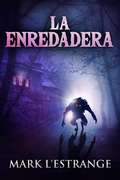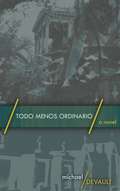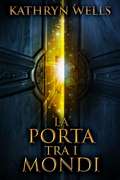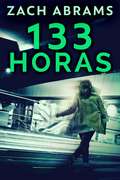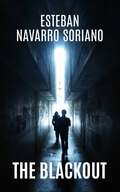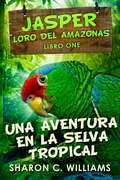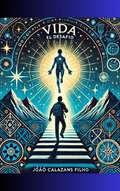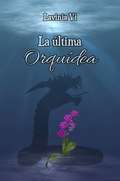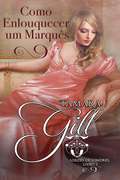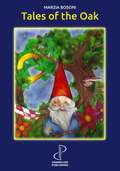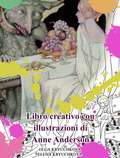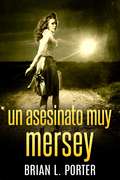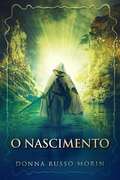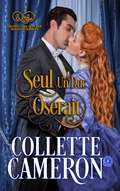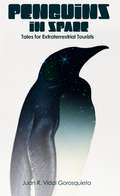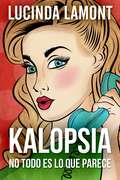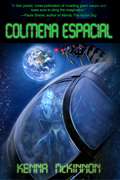- Table View
- List View
Nice Cream : 56 Recettes Végétaliennes de Crèmes Glacées à la Banane à Savourer Sans Culpabiliser
by Kelli RaeEtes-vous à la recherche d'un moyen sain et facile de déguster une crème glacée ? Ce livre est bien fourni avec 56 recettes de crèmes glacées à la banane à déguster sans culpabiliser. La nice cream est une gâterie simple et saine, idéale pour les journées chaudes d'été ou tout simplement pour un dessert sucré. La nice cream est un excellent substitut à la crème glacée, mais beaucoup plus sain. La crème glacée à la banane est faible en calories, en gras et toutes ces recettes sont végétaliennes. Elles sont toutes saines et minimalistes, parfaites pour toute perte de poids ou régime sain. En quelques minutes, vous pourrez déguster un dessert sans gluten, adapté à la diète paléo ou sans produits laitiers. Tout ce dont vous avez besoin est un mixeur ou un blender, quelques minutes et juste quelques ingrédients. Dans ce livre, vous trouverez les meilleures saveurs telles que le chocolat menthe, la pâte à biscuits, le chocolat, la menthe poivrée et bien plus encore. On m'a récemment diagnostiqué une hypothyroïdie. J'ai donc cherché ces recettes pour mon mode de vie vegan et sans gluten. Si elles fonctionnent pour vous aussi, je suis très contente ! Ceci dit, n'hésitez pas à remplacer n'importe quel ingrédient. Si vous avez des questions, je serais ravie d'avoir de vos nouvelles. Bonne lecture ! Quelques Astuces Voici quelques conseils qui vous aideront à réaliser la crème glacée parfaite à la banane. - Les bananes mures permettent d’avoir de meilleurs résultats. Heureusement, chez plusieurs marchands de fruits et légumes, les bananes mures sont bon marché. - Il vaut mieux peler les bananes avant de les mettre au congélateur. C'est BEAUCOUP plus difficile de le faire une fois qu’elles sont congelées. - Servez immédiatement pour obtenir une consistance yaourt glacé. Si vous préférez une consistance plus crème glacée, mettez le mél
La Enredadera
by Mark L'EstrangeAlgo malo acecha en el bosque, en las afueras de la ciudad. Vive en las sombras y ataca sin previo aviso, siempre con el mismo objetivo: mutilar, matar y devorar a su muerte. Es un monstruo con un anhelo caníbal por la carne humana y un apetito sexual que aparentemente no puede ser saciado. Ninguna víctima queda viva, y los restos dispersos divulgan muy poco al patólogo policial. A medida que aumenta el recuento de cadáveres, el superintendente a cargo de la investigación recurre a medidas desesperadas. Pero pronto, se hace evidente que la policía ha subestimado lamentablemente a su sospechoso. Un error que les costará caro.
Un Gain Mortel
by Zach AbramsPersonne ne pleure Scott Stevenson, un fauteur de trouble du coin, lorsqu’il est retrouvé une défense en ivoire plantée dans le torse. L’inspecteur en chef Alex Warren est chargé d’amener le tueur devant la justice. L’affaire se révèle être plus compliquée que prévue alors que son équipe commence à enquêter sur les nombreuses victimes de Stevenson. Quand ils découvrent par hasard une série de crimes motivés par le sexe et l’appât du gain, il devient clair que cette affaire n’est pas de celles qu’ils avaient imaginé. Les corps s’accumulent et les indices sont rares : Alex Warren et son équipe arriveront-ils à résoudre cette énigme avant que d’autres vies ne soient perdues ? Un Gain Mortel est un polar sombre et addictif, qui se déroule dans les rues de Glasgow gangrénées par le crime. Les compliments des lecteurs : ★★★★★ – « Une bonne sélection de personnages intéressants. » ★★★★★ – « M. Abrams est incroyablement doué pour faire revivre les rues poussiéreuses de Glasgow. » ★★★★★ – « J’ai eu tellement de mal à arrêter ma lecture que j’ai raté mon émission préférée du mardi ! » ★★★★★ – « Une échappée captivante, sombre mais pas trop. En tant que lecteur, j’ai apprécié chaque rebondissement. Le décor est rendu authentique par la connaissance personnelle de Glasgow qu’en a l’auteur, mais aussi par sa capacité à visualiser le mois de novembre écossais, triste et gris. Un choix parfait pour un roman policier. » ★★★★★ - "Les personnages étaient géniaux. La raison du meurtre était plausible. Ҫa pourrait arriver dans la vraie vie !"
Todo Menos Ordinario
by Michael DeVaultBilly Bradshaw solo tiene doce años cuando un juez de la corte juvenil lo sentencia a servicio comunitario y lo deja al cuidado de seis Bohemios ancianos en el Hogar de Liberty Street para Ancianos. Su verano da un giro inesperado cuando un nuevo administrador llegó a Liberty Street con planes para deshacerse de los problemáticos residentes del Pasillo B. Con la ayuda de la excéntrica hija del administrador, Cassidy, Bill se embarca en un viaje por el sórdido mundo clandestino de Nueva Orleáns para así salvar su hogar. Pero el verano trae el cambio mientras Billy inicia su camino hacia la adultez. Ante la tragedia, ¿podrá obligarse a enfrentar la vida y aprender lo que significa amar a alguien?
La Porta Tra i Mondi
by Kathryn WellsMichael è un giovane divoratore di libri che crede davvero nella magia. Michael è un giovane divoratore di libri che crede davvero nella magia. M in realtà lui non è preparato a ciò che si nasconde dietro la porta segreta della biblioteca della scuola: Treeshallow, un mondo parallelo di cui conosce già tutte le storie. Quando Michael incontra gli abitanti di Treeshallow, trova tutti i personaggi che aveva già incontrato nei libri. L'aspetto di Michael non fa pensare ad un incidente. Dopo aver cercato il famoso mago Ramble, i due capiscono che il bibliotecario della scuola, il signor Rogers, è stato catturato da un gruppo di demoni connosciuti come i Desrai. Ma anche con le loro forze messe insieme, possono salvare Rogers dalle grinfie del male?
133 Horas
by Zach AbramsChegando ao trabalho para descobrir que ela perdeu mais de cinco dias e meio de sua vida, Briony não se lembra de onde esteve ou do que aconteceu. Ela esteve doente ou sofreu um colapso - ou poderia ter sido drogada e sequestrada? Duvidando de sua própria sanidade, Briony tem medo do que está além da superfície, mas é levada a descobrir a verdade. Revendo suas escassas lembranças, ela percebe que algo terrível pode ter acontecido com ela durante o tempo em que não se lembra. Assistidos por suas amigas Alesha e Jenny, eles se unem a um detetive aposentado para descobrir a verdade. Mas onde ela esteve por 133 horas ... e por quê?
The Blackout
by Esteban Navarro SorianoIn a small town located in northern Spain, electricity has mysteriously stopped working. Batteries, cellphones, vehicles, and even all types of machines don't work anymore. The government sends several agents to investigate the murder of the owner of one of the bars in town, the rape of a girl, and the suicide of the local priest. Apparently, all those deaths are related to the blackout.
Jasper, Loro del Amazonas
by Sharon C. WilliamsJasper no es un loro cualquiera. Él vive en la selva tropical y está emocionado por explorar sus secretos. Jasper ama a su familia y su hogar, y también está a cargo de su hermano menor, Willie – una responsabilidad que Jasper toma muy en serio. Cuando conoce a Charlie – un mono araña con un amor por la comida y una personalidad relajada – se da cuenta que va a tener una aventura que nunca pensó que sería posible. A pesar de que eso signifique enfrentar peligros y preocupar a su madre hasta más no poder. Al explorar las fronteras de la selva, Jasper se da cuenta que el mundo es más grande de lo que creía. ¿Quiénes son esas extrañas criaturas que han venido aquí? Con Willie y Charlie acompañándolo, lo van a averiguar.
Vida - El desafío
by João Calazans FilhoEl libro es una reflexión sobre las etapas que la vida nos impone. El autor siempre fiel a su pensamiento estableció como base, política, religión y diplomacia. Los poemas de Vida - El desafío, tras la reflexión diaria del cotidiano común, en el que de forma filosófica deja espacios para que cada lector sienta como si fuese parte del pensamiento. La Obra es parte de búsquedas individuales, desvelando el entendimiento de quiénes somos, como nos imaginamos y cómo nos gustaría ser. Esta es una aventura poética del autor, y durante la lectura, nos sentimos un poco de brujo y mágico, con amplios poderes para justificar la intención de comprender mejor al ser humano y transformarlos en seres mejores.
La última Orquídea
by Lavinia ViLa vida de Anthea Grage es aparentemente normal. Vive en Portown, un pequeño pueblo en Maine, tiene una familia amorosa y una inseparable mejor amiga, Lyv, la única que conoce su oscuro secreto. Nadie más sabe que al anochecer los sueños de Ant están poblados no por miedos y deseos, sino por las sombras de los eventos que aún tienen que suceder. Cuando uno de sus sueños premonitorios anuncia la llegada a la ciudad de un joven misterioso y hermoso, Noah Shane, su rutina aburrida se pone completamente patas arriba. La niña de repente se ve obligada a cuestionar todo en lo que siempre ha creído. Las partes oscuras de su pasado golpean fuertemente su puerta para volver a la superficie y Caleb Shane, el gruñón primo de Noah, es quien parece saber precisamente esos secretos que ignora y que desea aprender a toda costa. ¿Anthea podrá descubrir sus orígenes... y sobrevivir?
Como Enlouquecer um Marquês (Lordes de Londres #2)
by Tamara GillEla salvou a vida dele, mas pode salvá-lo dele mesmo? Hunter, Marquês de Aaron, engana a sociedade. Externamente, ele é um cavalheiro de posição, com bons contatos, riqueza e charme. Interiormente, ele é uma bagunça. Seu vício — beber até um estado de estupor quase todos os dias — quase o mata quando ele entra na frente de coche de aluguel. Sua salvadora, a pessoa mais improvável, é a imagem de um anjo, mas com uma língua mais afiada que a bengala-espada dele. Cecilia Smith não gosta de ociosidade e desperdício. Se ela tivesse nascido homem, ela já estaria trabalhando para o escritório de advocacia do pai. Então, no dia em que ela estava atrasada para uma reunião importante sobre uma de suas muitas instituições de caridade, ela não ficou impressionada ao ter que intervir e salvar um cavalheiro embriagado e patife de ser atropelado. Quando suas esferas sociais colidem, Hunter fica surpreso e deslumbrado com a bela, e capaz, Srta. Smith. Cecília, por outro lado, fica confusa e nem um pouco receosa de verbalizar suas suposições sobre o Marquês e seus demônios. É impossível determinar se estas duas pessoas que pertencem a mundos tão adversos podem formar um mundo só deles...
Solo un duque lo logrará (Casarse con un pícaro, Libro dos #2)
by Tamara GillAntes de ser presentada en sociedad, Lady Isolde Worthingham capturó el corazón del duque de Moore en un baile country. Pero la noche antes de su boda, un escándalo alborota a la sociedad y hace que viaje a Escocia sola y con un compromiso cancelado, convirtiendo su perfecto y planeado futuro en un laberinto de deshonra y corazones rotos. Merrick Mountshaw, el duque de Moore, odia la lamentable situación en la que se ve envuelto y se esconde de la sociedad. Con una esposa escandalosa a la que nunca deseó, que hace alarde de sus indiscreciones, su vida se convierte en un infierno interminable. Cuando la mujer que amaba y había perdido vuelve a Londres, se da cuenta de que ya no puede vivir más sin ella. Sin embargo, los votos y el pasado duelen y no son fáciles de olvidar. El amor tal vez no pueda ganar la batalla contra la sociedad cuando un caballero muy adecuado y una señorita actúan según las reglas.
Tales of the Oak
by Marzia BosoniIn the depths of the wood, where trees are close together and the light only just reaches to dapple the ground, a large clearing opens up unexpectedly. There lives the old oak, who tells the wind the extraordinary adventures of the wood’s inhabitants. He tells it about Parpar, the Caterpillar who was always afraid because he knew a great Enemy lived in the woods; the beautiful Silverina, the waterfall fairy who fell in love with an elf of the trees; the old Rock, whose wisdom helped countless people, but could not save him from conceit; and about Ashur and the beautiful and sad story of his daughter, Bath-alon. The old oak of the clearing knows thousands of stories and loves to tell them to anyone who sits on the rock in the shade of his branches, or to anyone who, lying in bed, can smell the scent of the far-away wood.
Libro creativo con illustrazioni di Anne Anderson
by Olga Kryuchkova Elena KryuchkovaQuesto è un libro creativo interamente dedicato alle illustrazioni di Anne Anderson. Qui troverete immagini a colori e immagini in bianco e nero con campioni di colore. Se preferite, potrete fare uno screenshot dell'immagine in bianco e nero per colorarla sul computer o stamparla e dipingerla su carta. Nel dipingere, potete optare per il modello colorato e i campioni di colore proposti, oppure scegliere le soluzioni cromatiche che preferite per il vostro dipinto. Il libro creativo non ha limiti di età. Gli autori vi augurano un successo creativo e un piacevole passatempo! Questo libro può essere utilizzato come antistress o per l'Art Therapy.
Un Asesinato Muy Mersey
by Brian L. PorterInglaterra gana el mundial de fútbol. La misma noche, se descubre el cuerpo de una camarera cerca de un faro abandonado. Siguen dos asesinatos más; todos permanecen sin resolver. 2005. El DI Andy Ross es llamado cuando comienza una serie de asesinatos inquietantemente similares en el mismo lugar. Si sus estimaciones son correctas, Ross y su equipo tienen una semana para resolver el caso antes de que ocurra el próximo asesinato de Lighthouse. DI Ross y la sargento Izzie Drake intentan detener al cruel asesino. Pero con pocas pistas y aún menos evidencia, ¿podrán atraparlo a tiempo? Opinión: ★★★★★ - "Lo mantendrá al borde de su asiento". ★★★★★ - "Felicitaciones a Porter por continuar entregando historias de calidad con mensajes e imágenes poderosas".
Penny, la Cucciola della Ferrovia
by Brian L. PorterLa storia di Penny è il quarto libro di Brian L. Porter della serie vincitrice di premi sui cani salvati, e parla di un piccolo terrier, abbandonato in un modo particolarmente crudele, e della sua conseguente adozione e della vita insieme all’autore e alla sua famiglia. Dall’attacco da parte di un altro cane che porta ad un’operazione urgente, ai giorni sulla spiaggia cacciando i gabbiani, alle Case Signorili, la vita di Penny nel branco di cani di Brian non è stata altro che interessante e piena di eventi. Leggi la sua affascinante storia, una gradita aggiunta alla serie della Famiglia dei Cani Salvati.
O Nascimento
by Donna Russo MorinWiton ficou cansado da constante batalha entre as raças. Acompanhado de sua esposa, Belamay, e Persky - o primeiro meio Humano meio Elfo - Witon planeja criar uma nova sociedade: uma utopia para qualquer um que sonha em ter uma vida pacífica. O trio começa a recrutar seres de todas vilas e espécies. O grupo é divido, alguns partem para uma ilha promissora, a qual foi encontrada por acidente no meio do oceano agitado, os outros aguardam um sinal para se unirem a eles. A jornada é repleta de desafios, porém, nem um deles é tão terrível quanto o que enfrentarão em seu destino final. Eles terão a força e determinação para darem vida a um novo tempo?
Seul un duc oserait (Séduisants Scélérats #2)
by Collette CameronUn duc réticent. Une fille de pasteur. Un amour interdit. Le mariage – une obligation désagréable Un ajout ennuyeux au testament de son père oblige Victor, duc de Sutcliffe, à se marier avant son vingt-septième anniversaire, sans quoi il perdra sa fortune. Après une absence de trois ans, il revient chez lui, déterminé à trouver la demoiselle la plus docile et la plus insignifiante d’Essex. Une femme qui n’exigera rien de lui et ne sera pas importunée d’être laissée derrière quand Victor retournera à Londres. Sauf que Victor renoue connaissance avec Théadosia Brentwood et se retrouve impuissant à lui résister, même si elle est promise à un autre et qu’elle est exactement le contraire de ce qu’il pensait vouloir chez une duchesse. Le mariage – un choix impossible Secrètement amoureuse de Victor depuis des années, Théadosia est ravie quand il revient chez lui. Jusqu’à ce qu’elle apprenne qu’il doit se marier dans quelques semaines. Lorsqu’il la demande en mariage de façon inattendue, elle doit prendre une décision impossible. Comment Théa peut-elle s’enfuir avec lui quand il se marie par nécessité, et non par amour ? En outre, si elle épouse Victor, son fiancé – un homme qu’elle déteste – révélera un secret scandaleux. Un secret qui enverra son père en prison, et laissera sa sœur et sa mère sans abri.
Uma paixão volta no Natal
by Kris PearsonO surpreendente reencontro, por acaso, de Tony Robinson e Ellie McKenna na fazenda deste, que viúvo e precisando de uma turora para suas pequenas gêmeas, pede à sogra Ginny para contratar uma professora. Ao chegar, já no café da manhã, eles se reencontram e começa uma longa história de resgate da paixão de onze anos atrás, o primeiro amor um do outro, que resultou em Cal, o filho que Ellie tenta esconder de Tony.
El Cazador de Espías
by Robert MuccigrossoMás conocido en tiempos de paz por ser un detective privado de torpes maneras, Dick DeWitt se encuentra enrolado en el ejército de los EE. UU. durante la Segunda Guerra Mundial. Sin embargo, el ejército lo envía a la costa oeste para descubrir espías, quintos columnistas y saboteadores. Lo que el pobre DeWitt no sabe es que mientras él está buscando al enemigo, el enemigo lo está buscando a él.
Per sempre i suoi cowboy: Cowboys Online 5 (Cowboys Online 5 #5)
by Jan SpringerJennifer Jane (JJ) Watson ha trascorso gli ultimi dieci anni in una prigione di massima sicurezza. L’ultima cosa che si aspetta è di ottenere la libertà sulla parola e un lavoro come collaboratrice domestica di tre dei cowboy più sexy che abbia mai incontrato! Rafe, Brady e Dan pensavano che l’agenzia mandasse qualche ex detenuto a dar loro una mano con il ranch, e rimangono decisamente sorpresi nel veder arrivare una donna, per giunta molto attraente. Nelle terre selvagge e innevate del Nord Ontario, la compagnia femminile è cosa rara, ed è una vera fortuna che ai tre padroni di casa piaccia condividere la stessa donna... Il Natale sta arrivando ancora una volta al Moose Ranch e con l'avvicinarsi del parto, JJ si sta distraendo dagli attacchi di ansia di cui soffre tenendosi impegnata a prepararsi per l'arrivo del suo bambino e a organizzare la prima festa di Natale lì al ranch! Con un piccolo in arrivo, c'è molto stress per Brady, Rafe e Dan. Soprattutto a causa della decisione di JJ di assumere un’ostetrica che l’aiuti a partorire in casa e di avere tutti e tre i suoi uomini presenti al parto! Ma la preoccupazione e lo stress non impediscono loro di mostrare a JJ quanto la amano ... dentro e fuori dal letto! Nel vortice di continue bufere di neve, un aeroplano inutilizzato a terra, un party natalizio e un bambino in arrivo, i proprietari del Moose Ranch sanno che questo sarà un Natale che non dimenticheranno tanto presto... Un racconto della serie Cowboys Online ~ 1. Tre Cowboy per Natale (Moose Ranch #1), 2. Tre Cowboy Tutti Per Lei (Moose Ranch #2), 3. Innamorata Dei Suoi Cowboy (Moose Ranch #3) 4. I Cowboy del suo Cuore (Moose Ranch #4) 5.Per sempre i suoi cowboy (Moose Ranch #5) 6. Tre cowboy suoi per sempre (Snowy Creek Ranch #1)
Penguins in Space: Tales for Extraterrestrial Tourists
by Juan R. Vidal GorosquietaPerhaps an extraterrestrial tourist’s bedside book. Thirteen short stories in the science fiction and fantasy genre that are ironic, moving and humorous, with surprising and unsettling endings.
Kalopsia - No Todo Es Lo Que Parece
by Lucinda LamontKalopsia – (f.) La ilusión de creer que algo es más lindo de lo que en realidad es. Dicen que nunca sabes lo que pasa detrás las puertas cerradas, ¿pero también sabes lo que de verdad pasa fuera de tu puerta principal? Kate es una veinteañera, una mujer exitosa. Divertida, atractiva e independiente, al parecer todo le va bien. Pero cuando se trata de amor, Kate no reconocería una buena idea incluso si se detiene en un cruce peatonal y la ve pasar al frente de ella. Sufriendo en las manos de su mentalmente abusiva pareja, ella no tiene el coraje para irse. Así es, hasta que Greg muestra interés. Con Greg a su lado y ofreciéndole todo lo que ella ha querido, Kate cree que finalmente ha conocido a su príncipe. Pero ¿los sentimientos temporales tendrán consecuencias permanentes?
El Cubo y la Conquista de Torgas Prime
by Scott Michael DeckerDespués de que el salvador Jack Carson llega a la capital del imperio circiano muerto hace mucho tiempo, encuentra un cubo fantasma que le dice que ha sido elegido para convertirse en el próximo emperador. Aunque lo encuentra ridículo, Jack se une a una niña huérfana que dice ser la princesa de Circia. Preocupado por los divorcios, las bancarrotas y su constante búsqueda del olvido inducido por el humo, Jack intenta descubrir qué está sucediendo mientras evita a los agentes de cobro de deudas enviados por su ex esposa. A través de una serie de escapadas, Jack descubre más sobre sí mismo de lo que creía posible. Pero, ¿quién es la chica misteriosa, y podría tener razón el Cubo?
ColmenaEspacial
by Kenna McKinnon"SPACEHIVE es una polinización-cruzada de trama, a ritmo rápido, con gigantes avispas invasoras y abejas que seguro pica la imaginación de su público objetivo." —Paula Shene, autor de Mandy the Alpha Dog “A veces humorosa, a veces terrorífica, y siempre imaginativa, esta historia interplanetaria de alta tecnología te mantendrá zumbando página tras página. ¡Nunca volverás a ver a las abejas de la misma manera!” —Val Muller, autor de Corgi Capers: Deceit on Dorset Drive “Perversamente divertida y llena de sátira—un extraño y peculiar giro en el género de ciencia ficción que te dejará asombrado. ¡Altamente recomendado para jóvenes y sus padres por igual!"—Derrick Hibbard, autor de Impish “Muchas novelas tienen un aguijón en la cola, ¡SPACEHIVE esta literalmente llena de ellos! La disfruté muchísimo de principio a fin. SPACEHIVE no es solo imaginativa, sino también extremadamente estimulante. Un crédito absoluto para su autor recién estrenado. ¡Bravo!" —Philip Parry, autor de Wishful Thinking "No te dejes picar y te pierdas esta obra. Te colmenaras de una gran lectura y seguirás zumbando." —Alan Place, autor de Pat Canella: The Dockland Murders

